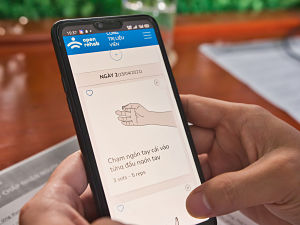share

A rehabilitation professional uses the OpenTeleRehab software in an HI training session, Vietnam 2021. | © C. Bachelerie/HI
Martin Jacobs, telerehabilitation Project Manager, answers common questions about the new telerehabilitation software that HI is launching in Vietnam
 OpenTeleRehab was inspired by the need to improve access to rehabilitation services in communities and strengthen discharge procedures. Many people have the mindset that there are rehabilitation professionals just around the corner at any given time, and that these services are easy to access. We need to realize that the context is different in different countries. People often need to travel to receive care. It’s costly for them to spend the money to travel, to pay for their consultation, and they miss out on earning income while they’re away from work. The software aims to avoid multiple trips back and forth, increase our capacity to provide services over a distance, and increase the ability to follow-up with patients. We have seen how useful telerehabilitation can be in situations like the COVID-19 pandemic, where physical services are closed- or in emergency settings where rehabilitation needs surge and hospitals must quickly discharge patients without a way to follow-up afterwards. With OpenTeleRehab, access can be improved because it reduces some of the current barriers to rehabilitation services
OpenTeleRehab was inspired by the need to improve access to rehabilitation services in communities and strengthen discharge procedures. Many people have the mindset that there are rehabilitation professionals just around the corner at any given time, and that these services are easy to access. We need to realize that the context is different in different countries. People often need to travel to receive care. It’s costly for them to spend the money to travel, to pay for their consultation, and they miss out on earning income while they’re away from work. The software aims to avoid multiple trips back and forth, increase our capacity to provide services over a distance, and increase the ability to follow-up with patients. We have seen how useful telerehabilitation can be in situations like the COVID-19 pandemic, where physical services are closed- or in emergency settings where rehabilitation needs surge and hospitals must quickly discharge patients without a way to follow-up afterwards. With OpenTeleRehab, access can be improved because it reduces some of the current barriers to rehabilitation services
It is important to rely on the expertise of rehabilitation professionals, who are trained to design individual treatment plans for optimal functioning. This helps prevent the possibility of further damage, which could be caused by following inappropriate practices or advice we may find online. Following a treatment plan remotely does not mean you are on your own. With OpenTeleRehab, even while you are remote, you are getting individualized care that is designed and adapted for you by a professional. Plus, users receive regular follow-up from their providers. HI’s approach is not only to facilitate service delivery, but to provide quality services. Our ‘Do No Harm’ mandate would not be fully respected if we allowed people to self-provide rehabilitation services.
In upper-low and middle-income countries, actually a large portion of the population has access to  smartphones. For example, I was surprised to see how many people in rural parts of Vietnam actually have smartphones and how common internet connection is. In some countries, this may be less true, but we can rely on hybrid approaches where we have tablets in local health community centers or schools for example. This means people will not need to have a device at home, and rehabilitation professionals will not have to travel all the way to the community.
smartphones. For example, I was surprised to see how many people in rural parts of Vietnam actually have smartphones and how common internet connection is. In some countries, this may be less true, but we can rely on hybrid approaches where we have tablets in local health community centers or schools for example. This means people will not need to have a device at home, and rehabilitation professionals will not have to travel all the way to the community.
OpenTeleRehab is specifically designed to use very little data and allow access to content even when offline, so it is ideal for low-connectivity settings or contexts where internet may come and go. Reports show that internet access is increasing every year, so it will become even more relevant for more regions over time.
OpenTeleRehab is patient-centered and has been designed for a wide range of users. The patient mobile app is really simple to use. Users will land on a homepage and it will immediately tell them what to do. There is also a child-friendly version, made specifically for younger users. We followed webcontent accessibility guidelines to ensure that the software is accessible to users of differing abilities, and we selected what we believed were the most relevant accessibility features for users. One of these is the ability to read the exercises aloud, for users with low vision.
We have also designed OpenTeleRehab to be culturally appropriate. After monitoring other software in various countries, we found that the illustrations were rarely appropriate or representative of the users. Our illustrations are gender-balanced, mostly age-neutral (with the exception of infants), and wearing loose-fitted full coverage clothing.








HI is an independent and impartial aid organisation working in situations of poverty and exclusion, conflict and disaster. We work alongside people with disabilities and vulnerable populations, taking action and bearing witness in order to respond to their essential needs, improve their living conditions and promote respect for their dignity and fundamental rights.
HI is an independent and impartial aid organisation working in situations of poverty and exclusion, conflict and disaster. We work alongside people with disabilities and vulnerable populations, taking action and bearing witness in order to respond to their essential needs, improve their living conditions and promote respect for their dignity and fundamental rights.